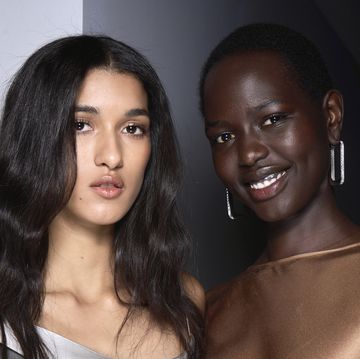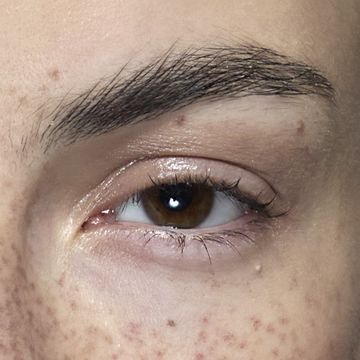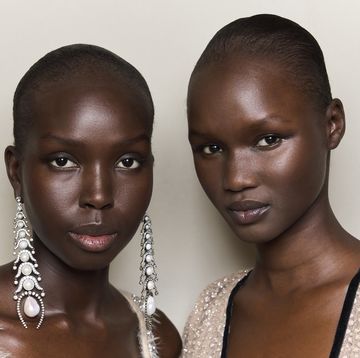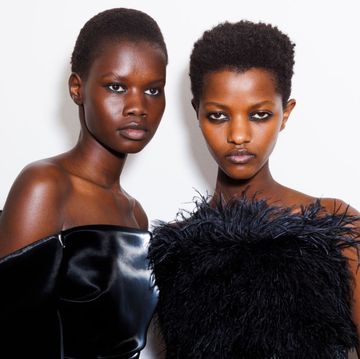It’s the end of June, the heatwave has finally arrived and I’m staring blankly at my wardrobe. The previous week I’d had a surgical procedure to remove the remnants of my second missed miscarriage this year. Until my sister experienced two in 2019, I naively thought that every miscarriage meant pregnancy loss through bleeding, but now I’m well aware that your body has a way of miscarrying unbeknown to you. It still thinks you’re pregnant, you still have snack attacks, and you still have unbelievably sore boobs (or at least I did), but what should be growing inside you isn’t. It’s stopped and you’re none the wiser until you go for a scan and you’re told there’s no longer a heartbeat, just heartbreak.
But this isn’t the reason I’m hovering aimlessly in front of my summer dresses on a sunny day. It’s the fact that, since my first miscarriage in January (which also resulted in surgery), I’ve broken out in acne. Not on my face, but across my back, chest and the tops of my arms, and it appears it’s not going anywhere any time soon. I'm traumatised because I want to wear something cool and strappy, but I can’t face the thought of revealing my skin. So now, as well as emotionally hiding what’s going on internally, I’m having to physically hide a visible reminder of my year so far. My breakouts are my battle scars, but no-one knows my fight, or not many at least.
Spots are par for the course when you’re having fertility treatment. But, in my case, I’ve been having treatment for years now and the breakouts have only appeared since I’ve had the miscarriages. Having worked as a beauty journalist for over a decade, I thought I’d be able to control the matter in hand. From talking to dermatologists and skin experts throughout my career, survival mode kicked in and I ticked off everything I’d heard them recommend with regards to ‘bacne’. Shower as soon as you’ve exercised; wash the conditioner out of your hair before you wash your body as it’s comedogenic and can block the pores; don’t wear tight clothing; use a low concentration salicylic acid cleanser. But nothing has worked and it’s been eight months and counting.
There’s the odd week when my newly acquired acne isn't as painful, but any sort of movement or rise in temperature that increases the blood flow to that area and it looks horrific. As well as struggling with what to wear on hot days, I’ve stayed away from the gym since it reopened post-pandemic, because I feel too self-conscious to wear a vest top. When I do venture to my beloved boxing or pilates classes, I’ve had to invest in t-shirts that make me overheat but that keep any embarrassment away. I appreciate this probably exacerbates the problem but I feel like it’s my only option.
What struck me though is that at least I knew all of these helpful tips. Others aren’t as fortunate to have such sources to hand and when I consulted Dr Google, there are forums full of women who have miscarried (both naturally and via fertility treatments) experiencing breakouts. On their face, neck, arms, back and chest, but there is very little information out there offering advice about how to address the issue. I turned to one of my go-to consultant dermatologists Dr Anjali Mahto who acknowledged the lack of help. 'You’re right, there are a couple of PubMed documents relating to acne and pregnancy but nothing about miscarriage,' she told me. At least my years of research skills hadn’t gone awry.
When investigating why this is happening, there is an explanation – some consolation at least. Firstly, there’s the extra progesterone coursing through your body. It's needed for the lining of the womb, but that has the side effect of increasing the size of the sebaceous glands, which means there’s a higher risk of spots. Then, there’s the stress that goes with the situation - not only as a result of miscarriage but the fact that you’re having treatment in the first place, it’s not exactly a walk in the park. That stress bubbles up, produces cortisol which, in turn, causes inflammation that then shows up as spots and redness. Great. The final nail in the coffin is that all the usual go-to treatments one would turn to for acne are out of bounds because you’re trying to conceive. That’s topical retinol and retinoids, as well as courses of Roaccutane.
With regards to where the acne appears, that’s just potluck. And so is how long it will last. 'After suffering a miscarriage your hormones can be severely unstable for weeks, or even months, which can lead to hormonal acne breakouts – on your chest back or face. There’s no real reason for it affecting one specific area as it can appear in any area that has oil-secreting glands or hair follicles,' Dr Hiba, consultant dermatologist and founder of Dermasurge, Harley Street told me.
As for the treatments, there are some things I’ve found I can slot into my regime that I haven’t tried at length yet. 'Ideally adding azelaic acid and benzoyl peroxide into your routine early can be beneficial and both are safe to use while trying to conceive and when pregnant,' confirms Dr Anjali. 'Apply a thin layer of benzoyl peroxide at night as a preventative method and then either use a 20% azelaic acid which you’d need on prescription or a 10% formula which you can get over the counter – this is good for inflammation and also pigmentation and scarring you might be experiencing from the spots.'
I could also consider speaking to a therapist or psychologist as I know full well the link between mind and skin but, right now, that feels too much. There are so many appointments already in the diary for hospital scans and tests, I’m not sure I have the energy to add another ‘to-do’ on my list that’s also littered with work deadlines.
Dr Anjali reassures me that I need to try and think of the breakouts as a temporary state of affairs and that, while it can’t be treated as quickly as if I wasn’t trying to conceive, it won’t last forever. It offers some comfort, but in this process that feels never-ending, it’s hard to focus on the fact that after two pregnancies all I have to show is tiny bumps across my back and chest when what I really want is one big bump on my belly.












